Research Article
AN EXPLORATION OF THE TOURISM VALUES OF NORTHERN GHANA. A MINI REVIEW OF SOME SACRED GROVES AND OTHER UNIQUE SITES
4359
Views & Citations3359
Likes & Shares
Aside optimization of amateurism, scientific and cultural values, the tourism prospects of the 7 regions constituting Northern Ghana from literature review reveals that each area contains at least three unique sites. These sites offer various services which can be integrated into value chains for sustainable medium and long-term tourism development projects. Joint efforts should be made by development partners such as UNESCO though its Man and the Biosphere Programs with Universities, and other innovative Research Institutions. A multi-sectoral approach should be adopted to assist the Government of Ghana inter alia, through the Ministries of Tourism, Arts and Culture, Lands and Natural Resources, Science and Environment to come out with dynamic ecotourism action plans. Heralding frantic attempts to fully develop the potential tourism sites by harnessing its resource bases alongside the development of an efficient rail-network transportation system - mark the ways forward for optimization of significant tourism benefits.
Keywords: Northern Ghana, Tourism sites/services, Optimization of tourism values, Government of Ghana
INTRODUCTION
Recent studies unveiled that the tourism sector which contributes about 3.5-4% of Ghana’s GDP and demonstrates great potential to improve the economic growth of the country by 2027, further caters for optimization of intrinsic satisfaction (amateurism) and extrinsic values such as scientific and cultural studies (Osei-Bonsu, 2016; Tiimub et al., 2020). Northern Ghana (NG) is so broad-based and encompasses, Northern, North East, Upper East, Upper West, Savannah and northern parts of the Bono East, Brong-Ahafo and Oti Regions of Ghana. The area is typified by prolonged drought, monomodal rainfall pattern, high sunshine intensity with temperatures often exceeding 45 °C, commonly manifested as part of guinea savannah and Sahel savannah local prevailing conditions (Tiimub et al., 2020; UNESCO 2006). The regions in NG are popular for its unique savannah grasslands that stretch far and wide with baobab trees standing strong atop the grasslands (Campbell, 2005). In this review, the potential ecotourism sites and the resources within them by specific references to sacred groves their locations in NG, suitably positioned for promotion of ecotourism value chains were tracked and discussed (Oduro & Okae-Kissiedu, 2006; Amoako-Atta, 1998, Tiimub et al., 2000). Ghana has about 1,904 sacred groves ranging from 0.5 to 1,300 hectares (Forestry Commission Act, 1990). Previous estimates indicate that the nation loses between 22,000 ha and 75,000 ha of the forest land annually through permanent conversion into agricultural lands, logging, mining and quarrying, fuel wood cutting, urban settlement, bush fires and to a lesser extent through gathering of minor forest products (Global Forest Watch, 1995-2020). Estimates between 2011 and 2018 statistics further indicate that Ghana losses a primary forest cover of 6,898.62 plant species representing 7.4% of the total forest cover annually. Sacred groves are believed to have been in existence for a very long time. They are inherited property of the surrounding communities from their ancestors often perceived as fetish places, good grounds for making traditional sacrifices and staging of religious prayer camps (Mohapatra et al., 2017, Nganso et al., 2011). The groves are protected from any degrading activities such as bush fires and cutting of trees. Albeit, some community sacred groves have bylaws for its protection whilst others rely on the authority of the traditional elders for protection and conservation of the unique biodiversity. "Tree cover threshold" has been used for defining the net tree coverage in sacred groves. For example, 75% includes only areas with more than 75% tree cover, reflecting dense canopies whereas 10% includes all areas with up to 10% tree cover with sparse canopy densities (Tiimub et al., 2020a). Traditionally and over the past two centuries, sacred groves have experienced environmental protection via cultural beliefs, byelaws and occasionally benefited from external scientific or management interventions delivered by NGOs and international organizations such as GACON and UNESCO under CIPSEG Project of 1992 (UNEP, 2012). (UNESCO, 2017). (UNESCO, 2018).
METHOD
A holistic evaluation of the key tourism sites by introspection of their resource potential within the ecotourism value chain was cross-examined based on revised literature accessed. And a descriptive information with some photographs were taken from the seven regions comprising northern Ghana in the scope of this current mini reviews (Figure 1). Appendix (Table 1) abducted from our previous studies). Aspects of the unique features, benefits, management and maintenance of sacred grove, as well as considerations on effective networking to address challenges and harness tourism sector gains have been summarily discussed.
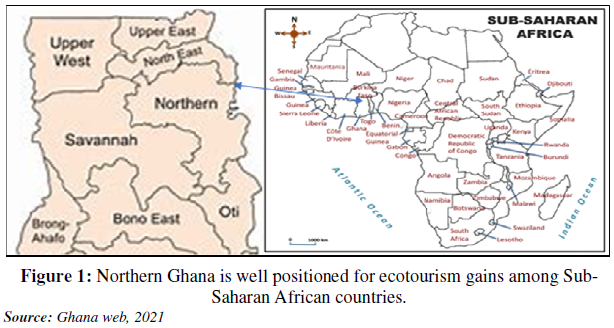
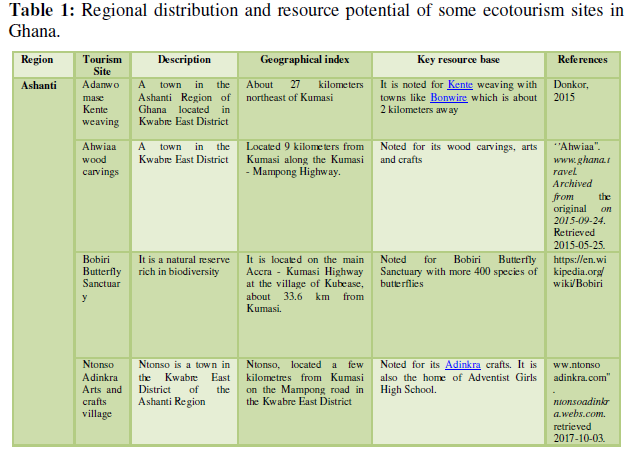
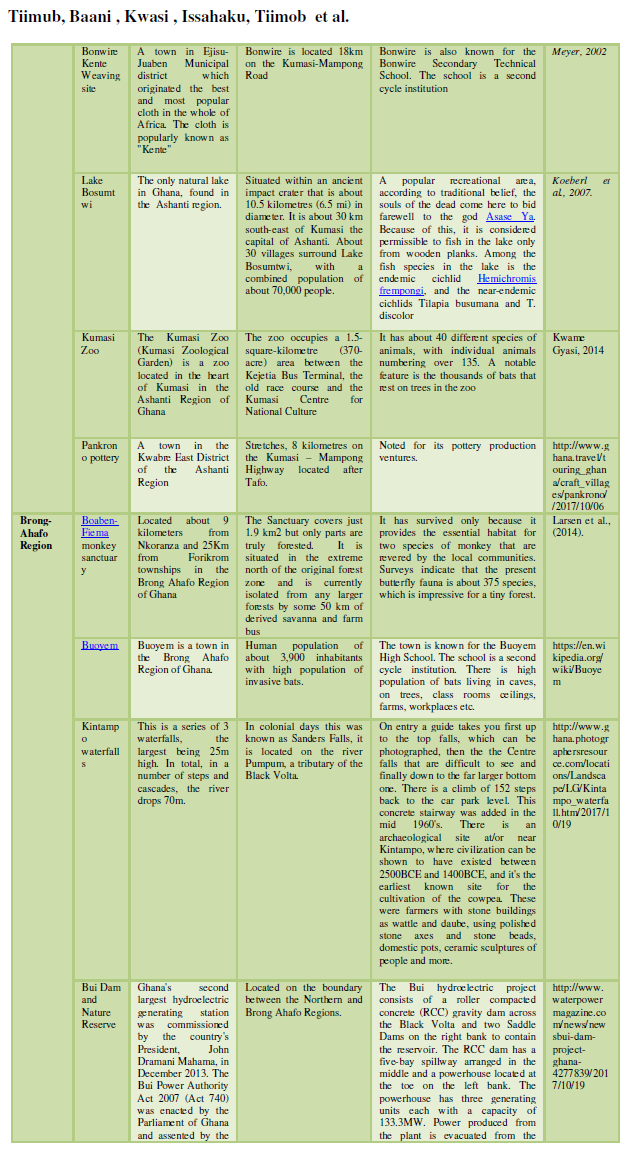
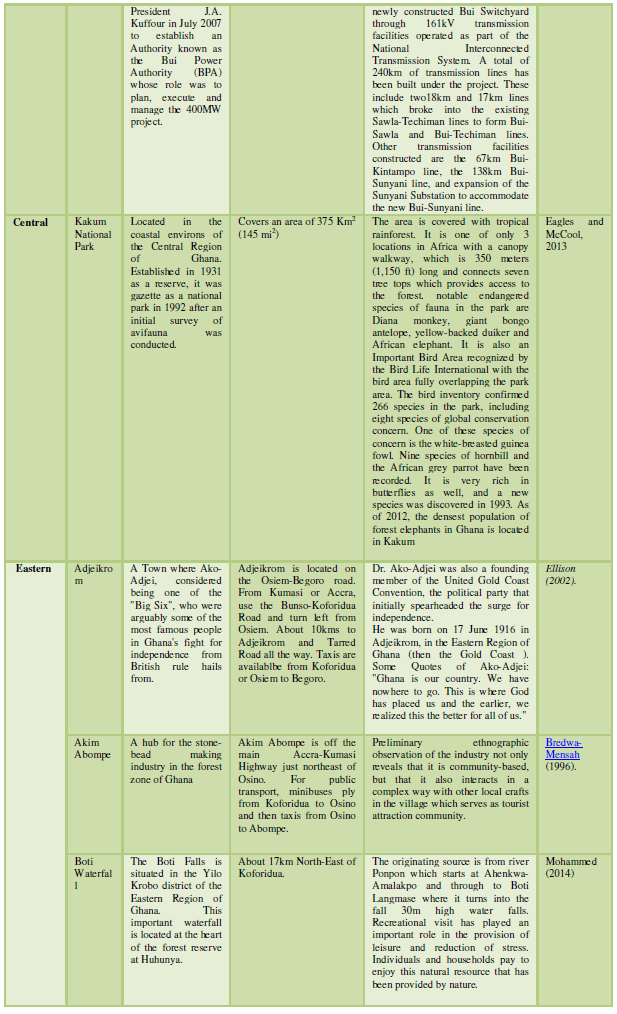
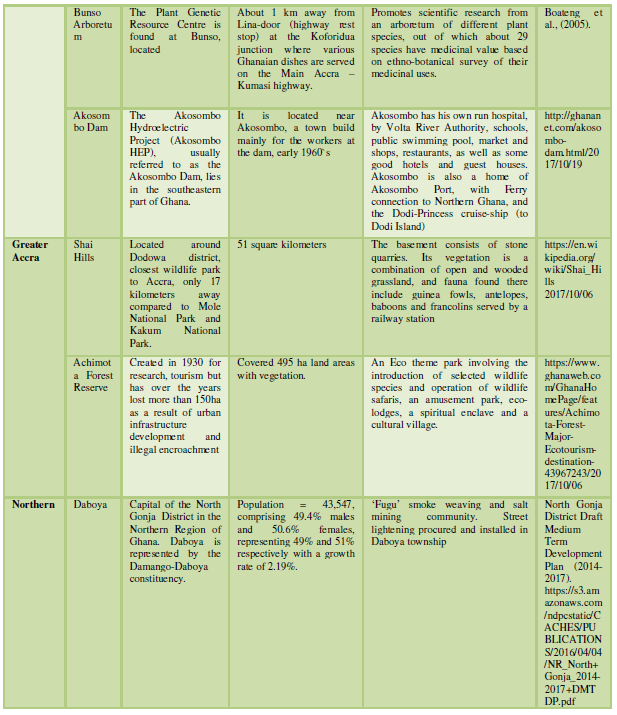
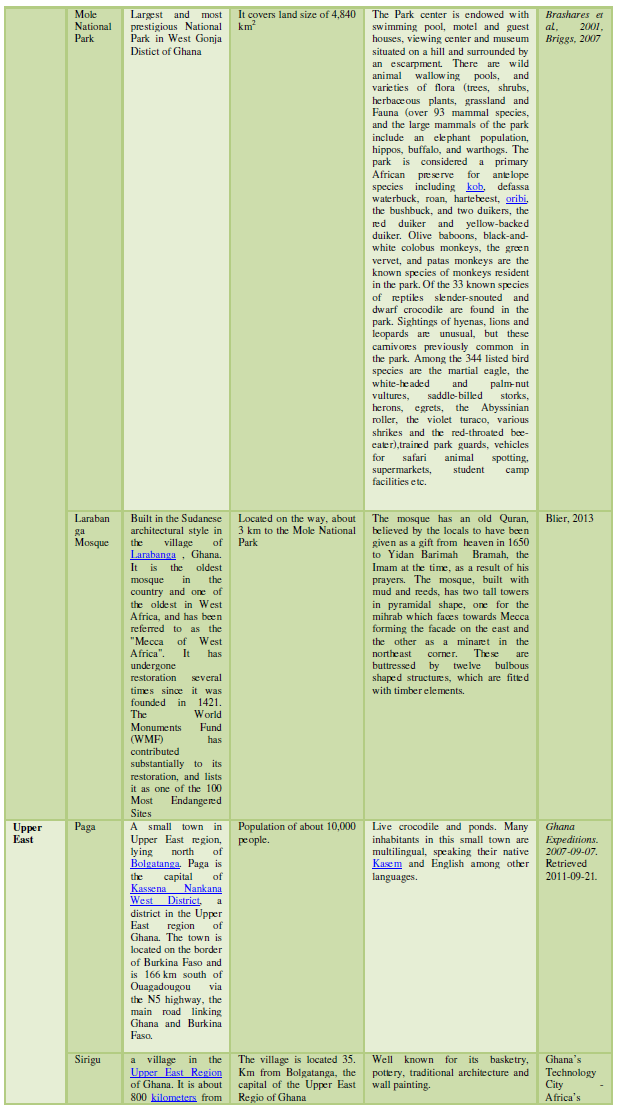
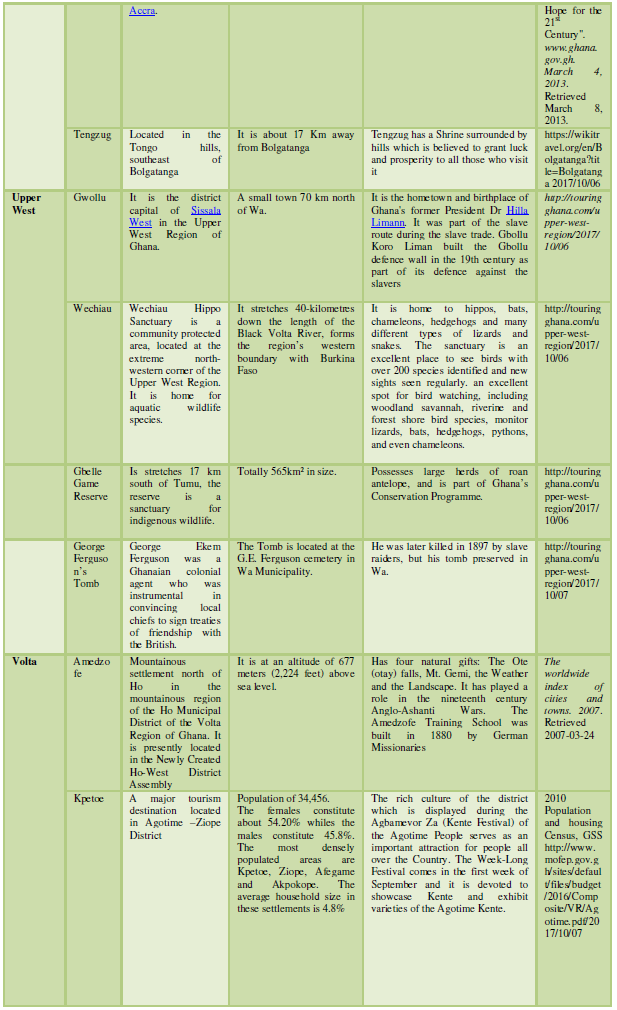
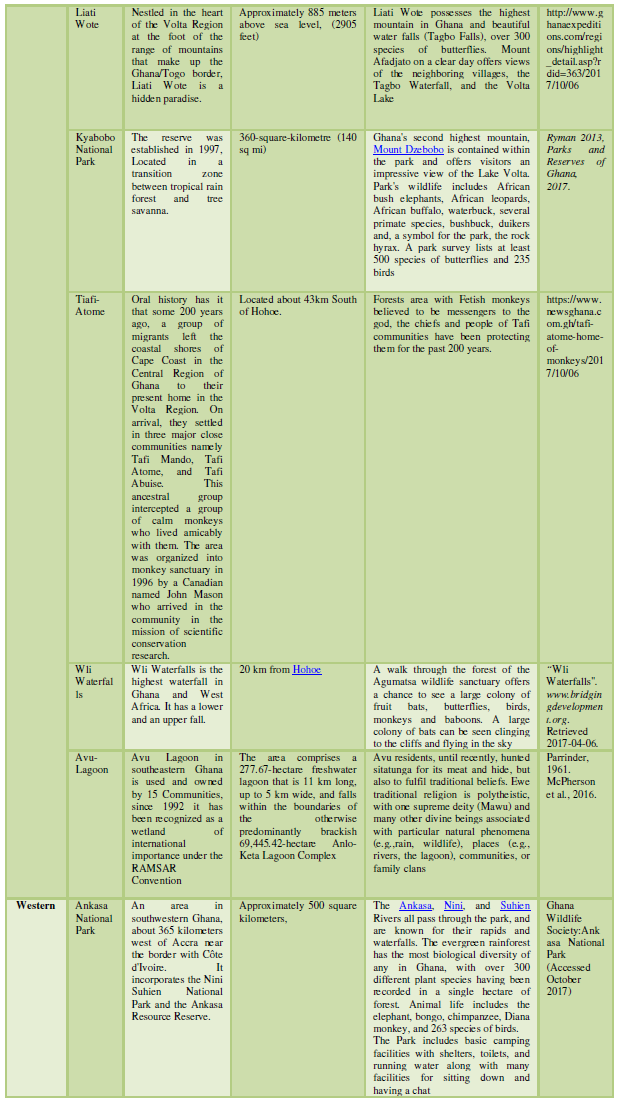

RESULTS
Valued sacred growth resources in Northern Ghana Telly earlier intimated that, in northern Ghana, the oral history of the Malshegu people reveals their torment by the Arab slave traders in the 18th century. An appeal to the Kpalevorgu deity, whose oracle is manifested in the form of a boulder under a baobab tree, finally enabled the indigenes of Malshegu to triumph (Telly, 2005). Currently, the Malshegu grove is protected by the community, and its lush forest stands out amid the relatively barren savannah vegetative cover around it. The indigenous community believes that Kpalevorgu provides them with rainfall, successful crop harvesting and fertility (Tiimub et al., 2020). At the same time, it has also protected the flora and fauna that have lost other canopy forest habitats.
Another sacred grove, Jaagbo in the Tolon district, also traces its origins to the protection of the community through traditional beliefs and bylaws. According to oral history, two epidemics struck the Tolon community in the 15th century, and soothsayers determined that the people had neglected Jaagbo which serves as the residing place of some twin gods. Hence, when the necessary sacrifices and rituals were performed at certain localities in the forest, the diseases ceased to spread. The gods are believed to take the form of leopards, crocodiles, or pythons; thus, none of these animals are killed or eaten at Tolon. Community members regularly consult Jaagbo for help in bearing children, healing the sick and bringing rain. Joint reverence for Jaagbo also keeps four different communities allied and brings them together for annual sacrifices (Tiimub et al., 2020). The Bontanga irrigation dam and Dalun water treatment plant which serves as the main potable water treatment source for the Tamale Metropolis and managed by the Ghana Water Company Limited are also located within the Tolon and Kumbungu districts.
The Portuguese first arrived in present-day Ghana in the 15th century and were smitten with the abundant gold they found. The British gained control of what was then called the “Gold Coast” until the country’s independence in 1957. European colonials divided Ghana’s land into parcels owned by individuals instead of the community, which broke down the traditional communal investment in land stewardship. They sought to grow non-native crops, which often destroyed the ecology of the local region and necessitated the use of fertilizers. Ghana’s vast forests were harvested for whole timber export without much value addition under sustainable yields concept (Campbell, 2005). Perceivably, the Church Missionaries tried to replace the worship of multiple gods that were manifest in natural phenomena like trees and streams within sacred groves with the worship of a True Messianic Christian God in their newly discovered environments (Anane, 1997).
Ironically, while European culture perceivably brought destruction to the land as a whole, it also sought to preserve small portions through the concept of wildlife reserves for scientific, cultural and educational functions (UNESCO, 2017). In as early as 1900, Britain passed a legislation that established protected areas within its colonies. Yet, the structure of these reserves only reflected the European ideology whereby, land inside the reserve was protected from random use, while land outside the reserve was open to any kind of development. In a sharp contrast, the traditional structure and management of sacred groves incorporates graduated zones: a highly protected core zone, which is only entered for ceremonial purposes; a buffer zone that permitted limited use of resources, and which scientists claimed correlates with a high level of biodiversity; and a surrounding transition zone that may support farming and logging, managed in an ecologically sustainable way (Oduro & Okae-Kissiedu, 2005, Telly, 2006, UNESCO 2006, Kuuder et al, 2013, IUCN 2010, Tiimub et al., 2020c). Following the adoption of wildlife reserves, the give-and-take preservation approach and graduated zones of conservation honed over centuries were dismantled, depriving indigenous people of their livelihood (rights to fish, hunt, and harvest natural forest resources) and the land of its equilibrium (IUCN, 2010).
The country’s first post-colonial wave of export timber harvesting began in the 1980s. Between 1990 and 2000, the mean annual rate of deforestation was reported at 1.7 percent, one of the highest in the world. Over the years, some 2,000 sacred groves exist in Ghana, making up 1.5 percent of its land. In these small patches of tree growths, however, an unparalleled level of biodiversity exists, and may serve as gene pools for species that have gone extinct elsewhere due to deforestation, higher population growth pressure and protracted changes in the land use forms (IUCN, 2010).
Other top regional tourist sites in northern Ghana
Top tourist attraction sites in the Savanna Region include the Mole National Park (a safari park that houses elephants, baboons, a few lions and leopards and other animals living in their natural habitats, plus several hundred of bird species with a hostel camping facility developed through the joint effort of Kwame Nkrumah University of Science and Technology’s Institute of Renewable Natural Resources and Mole Park Management for hosting students who embark upon various practical research activities). The Savannah region is also home to the revered Larabanga Mosque (built in the 13th century), the Daboya salt mines and traditionally woven smoke market, the Ndewura Jakpa Palace/Royal Mausoleum and Savanna Forest reserve at Damongo which contains the popular rose wood species, the Black and White Volta Rivers and local water transport services at Yapei, Buipe, Mpaha and the Volta Lake ferry and engine boat/canoe transport service run between Makango and Yeji. Salaga was an important town along the slave trade route from the northern parts of Ghana and Burkina Faso all the way down to the castles and forts along the Gold Coast (Mole National Park, 2015). The Kintampo waterfalls and center of Ghana ringed tree fence, Bui hydroelectric dam and Bia Forest reserve, located within the flanks of the Bono East region closer to the Savannah region further constitute adjacent ecotourism sites in northern Ghana (Tiimub et al., 2020).
The Upper East Region (UER) of northern Ghana is noted for its diverse cultures and history and the communal spirit among its indigenes. It contributes the second smallest land mass among the currently 16 administrative regions of the country. Popular tourist sites in UER include the Paga Crocodile Pond, Navrongo Cathedral, Bolgatanga art and craft market, Tongu hills and Tenzug shrines. The crocodiles live in the Paga Crocodile Pond, about forty-four kilometers from Bolgatanga, the regional capital, where they swim merrily along side young children while their mothers wash clothes on the banks. The people of Paga claim that, no one has ever been harmed by any of the crocodiles. The crocodiles are equally respected by the citizens who believe that the soul of every native of Paga is carried by these animals (Patoway, 2015). Besides, whenever any important personality in the village dies, it is followed by the death of one of the sacred crocodiles because it is believed that the crocodiles are somehow connected to their ancestral spirits. By this perception, the crocodiles are therefore, well protected and regarded as being sacred in the community. The indigenes of Paga ensure the crocodiles are fed by offering them sacrifices of live fowls. Scientifically, crocodiles are carnivorous and generally aggressive, but not in the town of Paga. Through natural acquaintances to adaptive animal behavior, the crocodiles have in turn learned to live harmoniously with the people. This phenomenally unusual friendship between the people of paga and the crocodiles does not however render the reptiles as being naturally totally harmless, particularly if threatened or endangered by externalities (Bateman and Fleming, 2012).
Plated photographs (Figure 2, 3, 4) indicating some unique tourism sites in the Upper East Region of Northern Ghana.
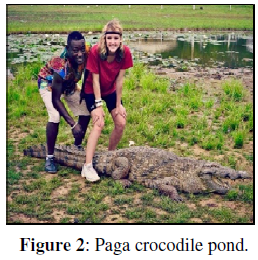
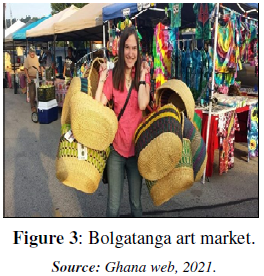


The Navrongo Cathedral is one of Ghana’s oldest Churches. Our Lady of Seven Sorrows Cathedral was built in 1906 by the Europeans. The walls of the cathedral were built with mud, explaining why it is sometimes called the mud cathedral. On the inside, it appears like many other Catholic Churches with pictures of events in the time of Jesus pasted on the wall. Being one of the oldest Churches in the country, the people that visit it are not entirely there to worship. Many of them are
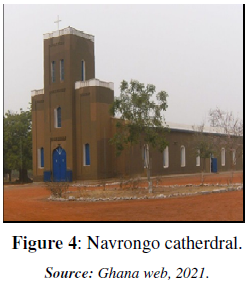

tourists who come to feast their eyes on that ancient piece of beauty. In the Bolgatanga market, the most popular products displayed are straw woven baskets, called Bolga baskets. In farming seasons, many agricultural products are sold there. The things that make the Tongo community a popular tourist attraction site are their festivals, the Tenzug shrine and the whispering rocks. The people of Tongo are deeply traditional people who often worship at the shrine which is perceived to grant good luck and prosperity to its visitors. The Tongo ills are also known for their many astounding, natural rock formations (UNESCO, 2018). The Via dam at Bongo and Tono dam at Navrongo are major water sources for irrigation, flood control and recent Government of Ghana Flagship irrigation farming for food security enhancement programs and other development projects in northern Ghana (Agbeko et al., 2019).
In the North East Region, we have the Gambaga-Nanpkanduri scarp, the mystic wall, the Nayiri Palace and Baptist Medical Centre at Nalerigu, as well as the Old District Court, Prisons and Witches Camp at Gambaga. Historically, Nalerigu is where that reinforced mud defense slave wall – akin to the Great Wall in China, was constructed by the locals to protect the community against slave-raiders in the Gold Coast colonial era (UNESCO, 2018).
The Upper West Region makes up 3% of the total land mass of Ghana. Popular tourist sites in UWR include the Wechiau hippopotamus sanctuary (Figure 5). Gbollu slave defense wall, the George Ferguson’s tomb in Wa and Gbelle game reserve. Wechiau is a home to most of the country’s hippos. There is nowhere else in the country to find more of these hippos which can be well spotted closely on canoe rides along the river. Around the hippo sanctuary it is very common to spot chameleons, monitor lizards, hedgehogs, snakes and many other animals. There are up to 200 different bird species nesting within this hippo sanctuary enclave. This reserve mainly serves as a home to many endangered animals. Wild animals in Wechiau sanctuary are conserved for natural reproduction, to populate and keep them alive for sustainability functions. The most valued and protected animal species in the sanctuary comprise of hippos, water bucks and some endangered bird species (IUCN 2010, Kuuder et al., 2013).
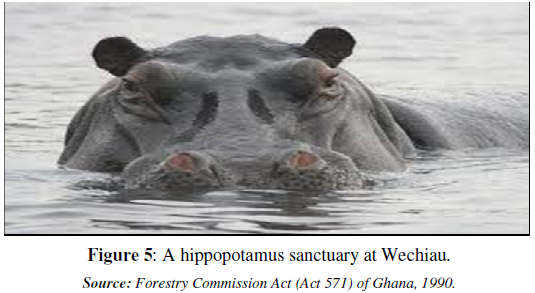

DISCUSSION
Unique features of the sacred groves
The Tindangung sacred grove in Saveligu-Nanton District has a mystic stone at the middle of the shrine, monitor lizards, pythons and other wildlife that gallivant the forest. However, of the total respondents interviewed in both communities in a recent survey, about 97.5% of them intimated that the history of the sacred grove attracted people while 79.5% felt it was rather the routine religious rituals performed therein, which brought visitors. The floral diversity components of the sacred groves are found to attract more tourists or researchers. Wuerthner and Hang et al., both intimated on the uniqueness of flora for touristic attraction as similarly echoed by Cobbina et al., in Ghana (Wuerthner, 2020; Hang et al., 2019; Cobbinah et al., 2015). Exemplarily, the beneficial objective for establishing any forest protection and sacred grove projects in any locality is mainly to enhance ecotourism functions (Hausner et al., 2017, Hang et al, 2019, UNESCO, 2018, Tiimub et al., 2020). The current review analyses further dilate on the prospects of expanding ecotourism by conserving the unique potential features of sacred groves to promote local and international tourism. Apparently, both Jaagbo and Tindangung sacred groves in northern Ghana are enriched with the unique features which significantly showcase their potentials for sustainable ecotourism development functions. The Jaagbo sacred grove for instance has about 220 different species of plants. Besides, paths have been created leading to certain adventitious spots such as the crocodile pond, bird sanctuary and historic baobab tree that is longitudinally imprinted with horse foot (Telly, 2006).
Benefits of the sacred groves
In Asian sacred sites for instance, many of the community members placed great values on their sacredness due to some associated benefits and categorized them into two: firstly, the environment and the second, social (Verschuuren, 2016). Linked to these value system ideologies, some recent tailored results confirmed that about 60% of respondents in the recent Ghanaian study intimated that both the Jaagbo and Tindangung groves offer the surrounding communities rain and protection against strong wind slides while 40% showcased the groves as indirect sources of income from tourism functions (Tiimub et al., 2020). These groves were attributed as healing sources once about 60% of medicinal plants or animals are obtained to treat various diseases. The groves further constituted spiritual grounds for performance of traditional sacrifices to localized ancestral gods of the lands. About 83% of the community members accentuated that they obtained wild fruits and mushrooms which serve as asynchronous sources of food security for the people to break hunger pulses. Their beliefs were strongly pinned towards quick conversion of the groves to ecotourism centres so that better care and management could be devoted to conserve both the medicinal and non-medicinal plants species and to promote ethnobotanical studies by researchers from the adjoining academic institutions. Examples of medicinal tree species within the groves are Alstonia boonie, Tamarindus indica and Azadirachta indica (Tiimub et al., 2020). These tree species were also intimated by 80% of the respondents to be efficacious towards local treatment of stomach upset and dysentery and were also used to assist in the delivery of placenta during labor when the barks are processed.
The fore findings ultimately confirmed that sacred groves classically provide a number of benefits to local indigenes in the communities and entire nation as obviously intimated by various experts (Halley et al., 2016; Bicknell et al., 2017; Brambilla and Ronchi, 2016; Bailey et al., 2016; Oyebamiji, 2019). These inexhaustive benefits according to expressions of the subjects interviewed in recent studies of Tiimub et al., on sacred groves as potential ecotourism sites at Tolon and Diare were summarized in brackets as follows: [i. it constitutes research base for students and scientists (38 respondents out of 40 affirmed this point, totaling 95%); ii. it further promotes cultural values once it is often used as special burial grounds, religious or spiritual functions for some members of the community (29 out of 40 respondents sided with the idea, making 72.5%); iii. its ecological role promotes carbon sequestration and protection of water bodies, provision of habitat for conservation of wildlife species and air purification of polluted systems through phytoremediation, natural decomposition and bioremediation of both water and soil pollutants (100% affirmed the point); iv. the groves also permit limited collection of non-timber forest products such as medicinal plants or animals, mushrooms, chewing sticks, rafters and poles for erection of household roofs (intimated by 94% of respondents] (Tiimub et al., 2020).
Management and maintenance of the sacred groves
Majority (90-95%) of the respondents in recent surveys of Tiimub et al., attested that successful traditional means of sacred groves protection was attributable to factors earlier on detected by Telly such as: use of the groves to promote ancestral worship apart from rendering sacrifices to the local gods (Tiimub et al, 2020a; Telly, 2003). The use of taboos also restricts the level of activity in the grove to some particular days in the week. Despite all these perceptions and claims, most respondents remarked on the need to ensure proper conservation of fauna and flora at the groves as part of environmental sustainability and tourism functions. For instance, 75% of the subjects suggested maintenance and preservation of roses and other woody species in the grove while 25% posited that avoidance of bush burning were generally crucial measures of grove sustainability functions. Additionally, 92.5% of the community members opined on development of the groves into tourist centres as the best land use alternative for preservation of important plant genetic resources. According to them, it serves as the way forward for enhancing sustainable utilization and management of natural resources (Tiimub et al., 2020). These opinions also linked up appropriately with sustainable natural conservation principles because the findings corroborated strongly with the historic forest resources development agenda of Ghana (Ormsby, 2020). It has been since 1887 that the Colonial government set up steps towards sound conservation of certain forest areas of Ghana. Thus, forest reserves were established to protect agriculture lands from erosion, maintain equilibrium in climatic conditions and sustain river sources. However, most sacred groves laid outside confines of the forest reserves and have been adversely subjected to protracted vulnerability because of both natural and anthropogenic disturbances (Nganso et al., 2011; Amoako-Attah, 1998).
Considerations on effective networking to address challenges and harness tourism sector gains
Some of the major trajectories against the tourism sector development have been lack of international cooperation and integration among the service providers and concerned authorities, as well as the difficulty involved in sustaining multisectoral participation of different interest groups in tourism activities in situations whereby, certain factors and strategies are particularly required to drive the choices of women graduates to venture into the tourism and hospitality business sector (Kobra et al., 2019). For instance, tourism investment is very crucial in Bangladesh in contrast with the neighboring countries (Kobra et al., 2018). An avenue to promote globalization of tourism and hospitality industry may be the option to develop effective and efficient rail-network transportation systems to enhance intercountry transportation of raw materials, intermediate products and finished goods (Karim, et al., 2020). On attempts to utilizing the long-distance competitive advantage of rail transport systems, the Trans Asian Rail-network has a major role to play in bringing a more even distribution of economic opportunities and benefits across nations by reducing barriers and corruption possibilities on tourism investment climates when the roles of the civil societies are well respected (Kabir, et al., 2021). Aside globalization, regional integration can determine the vulnerability of climate change in agriculture and food security by co-opting measures which influence the sustainability of ecotourism functions (Hossain, et al., 2013). Ghana is currently partnering China in developing its railway sector with neighboring African countries such as Burkina-Faso in order to harness tourism sector gains whilst globalizing businesses through its Ports and Harbours Authorities. In this regard, Beijing is financing US $2 billion worth of rail, road and bridge networks, and in exchange, China will be granted access to 5% of Ghana’s bauxite reserves (Smith, 2019).
CONCLUSION
The main tourism sites and services captured in the review from northern Ghana included but not limited to sacred groves, national park with student hostel camping facilities, unique Cathedral and Mosque, art and craft market, crocodile pond, mystic stone, natural hills and shrines, hippopotamus sanctuary, game and forest reserve, hydroelectric dams, traditional smoke markets and salt mines, mystic wall, witches camp, Gospel Missionary medical centre, traditional palaces and mausoleum, scarps, among others showcased (Table 1). These sites actually require significant improvement in terms of sustainably adoptative conservation initiative so as to optimize prospective gains. Therefore, the Government of Ghana ought to partner stake holding communities, NGOs and private sector investors to identify new and reliable aspects for synergism. One transformable strategy is to exploit the knowledge of environmental/ecological engineers and conservators towards repackaging of tourism sector strategic investment policies in order to create balance in terms of infusing beneficial projects/programs that promote multisectoral participation, effective rail-network transportation systems into any sustainable tourism development planning initiative. It is also ascertained that international partners interested in promoting tourism sector investment policy initiatives with Government of Ghana (GoG) can collaborate with the higher institutions such as Kwame Nkrumah University of Science and Technology, Kumasi, University for Development Studies at Tamale, Simon Diedong Dombo University of Business and Integrated Development Studies in Wa, the Wa, Tamale and Bolgatanga Technical Universities, the Northern Parliamentarians and Ministerial Caucuses of GoG for better collective bargaining agreements. The institutions already run well-structured multifaceted academic programs on tourism, hospitality, environmental management/sustainability and can better assist in identifying aspects for effective collaboration for research to herald tourism development programs in Northern Ghana.
- Agbeko, E., Agbo, N., Agyemang, T., & Boateng, D.A. (2019. Water Quality Status of Tono and Vea Reservoirs for Aquaculture Development in the Upper East Region of Ghana. Asian Journal of Fisheries and Aquatic Research 3.
- Atta, B.A. (1998). Preservation of Sacred Groves in Ghana Esukawkaw Forest Reserve and its Anweam Sacred Grove Paris UNESCO Division of Ecological Sciences South South Cooperation Programme.
- Anane, M. (1997). Religion and Conservation in Ghana.In Implementing Agenda 21 NGO Experiences from Around the World edited by Leyla Alyanak and Adriene Cruz. New York United Nations Non-Governmental Liaison Services.
- Bailey, K.M., McCleery, R.A., Binford, M.W., Zweig, C., Bailey, K.M., et.al,. (2016). Land-cover change within and around protected areas in a biodiversity hotspot. Journal of Land Use Science 11, 154-176.
- Bateman, P.W., & Fleming, P.A. (2012). Big city life Carnivores in urban environments. Journal of Zoology 287(1), 1-23.
- Bicknell, M.B., Collins, R.S.A., Pickles, N.P., McCann, C.R., Bernard, D.J., et.al., (2017). Designing protected area networks that translate international conservation commitments into national action. Biological Conservation 214, 168-175.
- Brambilla, M., & Ronchi, S. (2016). The park view effect Residential development is higher at the boundaries of protected areas. Science of the Total Environment 569-570, 1402-1407.
- Campbell., Michael, O. Neal. (2005). Sacred Groves for Forest Conservation in Ghana’s Coastal Savannas. Singapore Journal of Tropical Geography 26.2, 151-169.
- Cobbinah, R.P., Black, R., &Thwaites, R. (2015). Biodiversity conservation and livelihoods in rural Ghana Impacts and coping strategies. Environmental Development 15, 79-93.
- Forest Commission Act. (1990). Forest Commission Act of Ghana. Summary of components. Date of notification 10th September 1-18.
- Ghanaweb. (2021). Ghana Expeditions.
- Global Forest Watch. (1995-2020). Tree cover loss: Hansen UMD Google USGS NASA. Administrative boundaries Global Administrative Areas database version 3.6. Mongabay.
- Halley, J.M., Monokrousos, N., Mazaris, A.D., Newmark, W.D., & Vokou, D. (2016). Dynamics of extinction debt across five taxonomic groups. Nature Communications 7, 12283.
- Hang, W., Lee Saiful, L., & Abdullah, A., (2019). Framework to develop a consolidated index model to evaluate the conservation effectiveness of protected areas. Ecological indicators 102, 131-144.
- Hausner, V.H., Engen, S., Bludd, E.K. & Yoccoz, N.G. (2017). Policy indicators for use in impact evaluations of protected area networks. Ecological indicators 75, 192-202.
- Hossain, S., Zayed, N.M. & Mukul, A.Z.A. (2013). Regional Integration and Determining the Vulnerability of Climate Changes in Agriculture and Food Security in South Asia. European Journal of Business and Social Sciences 2(2), 30-45.
- International Union on Conservation of Nature (IUCN) Programme Afrique Centrale et Occidentale (PACO) (2010). Parks and reserves of Ghana Management effectiveness assessment of protected areas. Ouagadougou BF UICN PACO.
- Kabir, M.R., Khan, S., Chowdhury, S., Jahan, S., Islam, K.M.A. et.al., (2021). Corruption Possibilities in the Climate Financing Sector and Role of the Civil Societies in Bangladesh. Journal of Southwest Jiaotong University 56(2), 55-64.
- Karim, M.S., Zayed, N.M. & Afrin, M. (2020). Trans Asian Railway Network: A Get way to the East and West to Attain Sustainable Development Goals. International Journal of Arts and Social Science 3(3), 130-141.
- Kobra, M.K., Khalil, M.I., Rubi, M.A., Kulsum, U. & Zayed, N.M. (2019). Factors and Strategies to Drive the Choice of Women Graduates to Enter into Tourism and Hospitality Sector A Perceptual Strategic Study. Academy of Strategic Management Journal 18(6), 1-7.
- Kobra, M.K., Bhuiyan, K.H. & Zayed, N.M. (2018). Well and Woes of Tourism Promotion in Bangladesh Investment Perspective. Academy of Accounting and Financial Studies Journal 22(3), 1-8.
- Kuuder, C.J.W., Bagson, E. & Aalangdong, I.O. (2013). Livelihood enhancement through ecotourism a case of Mognori Ecovillage near Mole National Park Damongo Ghana. International Journal of Business and Social Science 4(4), 128.
- Mohapatra, P.P., Dash, P., Shekha, H., Palei, H.S., & Debata, S. (2017). Ecological and Social Aspects of Biodiversity Conservation in Sacred Groves of Bonai Forest Division Odisha India. In book Biodiversity conservation and Wildlife Management. North Orissa University Project Protection and Conservation of Sacred Groves of Bonai division in Sundargarh district of Orissa.
- Mole National Park. (2015). Mole Management. Wildlife Division of the Forestry Commission.
- Nganso, T.B., Kyerematen, R. & Obeng Ofori, D. (2011). Impact of sacred groves on biodiversity conservation in Ghana. Current Trends In Ecology 3, 1-10.
- Oduro, K., Antwi, K., & Kissiedu, O. (2005). Restoration and Sustainable Management of Forests in Ghana. Paper presented at the Tropenbos International Ghana Workshop Elmina Ghana 5-7.
- OseiBonsu, C. (2016). CEO Ghana Tourism Authority Interview Tourism chapter from The Report Ghana. UNESCO World Heritage Centre. Mole National Park.
- Ormsby, A. (2020). Cultural and Conservation Values of Sacred Forests in Ghana.
- Oyebamiji, U.A. (2019). Adventure in a Sacred Grove. Terra Incognita Discoverer Ethical Ecotours.
- Patoway, K. (2015). The Friendly Crocodiles of Paga. Amusing Planet.
- Smith, E. (2019). Chinas $2 billion deal with Ghana sparks fears over debt, influence and the environment. WORLD ECONOMY.
- Telly, E.M. (2003). Developing the Jaagbo Sacred grove: In the Tolon Kumbungu District Unpublished.
- Telly, E.M. (2006). Sacred Groves Rituals and Sustainable Community Development in Ghana. In Conserving Cultural and Biological Diversity The Role of Sacred Natural Sites and Cultural Landscapes edited by Thomas Schaaf and Cathy Lee Paris UNESCO.
- Tiimub, B.M., Kuffour, R.A., Tiimob, R.W., Kuuyeni, C.A., Tiimob, E.L., et.al., (2020). Sacred groves as potential ecotourism sites at Tolon and Diare in Northern Region Ghana. Journal of Sustainable Tourism and Entrepreneurship 1(3), 195-215.
- Tiimub, B.M., ObiriDanso, K., Dartey, E., Kuffour, R.A., AmihereAckah, P., et.al., (2020b). Strategic Environmental Assessment of Visitor Perception Ebola Risk Factor and Water Quality of Mole National Park for Sustainable Ecotourism Functions. Journal of Tourism Hospitality and Environment Management 5(20), 16-52.
- Tiimub, B.M., Gbolo, B., Tiimob, R.W., Tiimob, E.L., Kumedzro, V., et.al, (2020). Impact of community participation in adaptive wildlife resources management at Mole National Park Ghana. Journal of Sustainable Tourism and Entrepreneurship 1(2), 139-149.
- United Nations Commission on Sustainable Development. (2008). Buoyem Sacred Grove Conservation Project.” Sustainable Development Success Stories.
- UNEP (United Nations Environment Programme). (2012). Keeping Track of Our Changing Environment From Rio to Rio+20 Nairobi United Nations Environment Programme.
- UNESCO (United Nations Education Scientific and Cultural Organization) (2018). UNESCO Initiative on Heritage of Religious Interest.
- UNESCO (United Nations Education, Scientific, and Cultural Organization) (2017). A New Roadmap for the Man and the Biosphere (MAB) Programme and Its World Network of Biosphere Reserves Paris UNESCO.
- United Nations Educational, Scientific and Cultural Organization (UNESCO) (2006). “Bia Biosphere Reserve. Man and Biosphere (MAB) Biosphere Reserve Directory.
- Verschuuren, B. (2016). Re-awakening the Power of Place. In Asian Sacred Natural Sites Philosophy and Practice in Protected Areas and Conservation edited by Bas Verschuuren and Naoya Furuta, 1-14.
- Wuerthner, G. (2020). Preserve the sacred lands of the Greater Yellowstone Ecosystem. The Wild life News 31.







